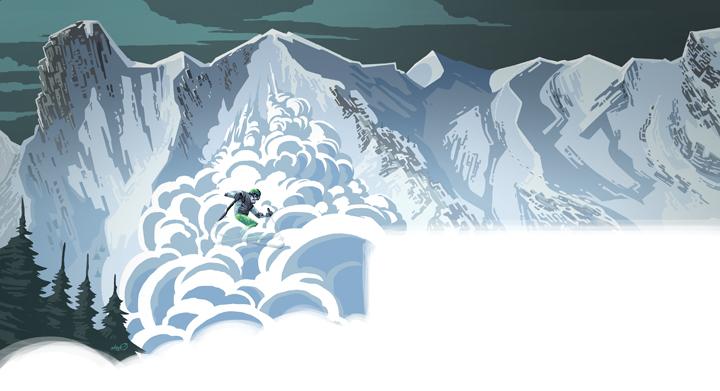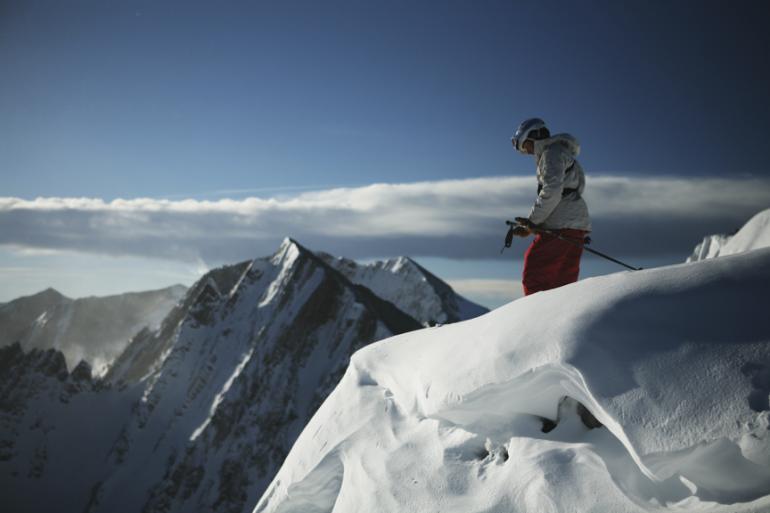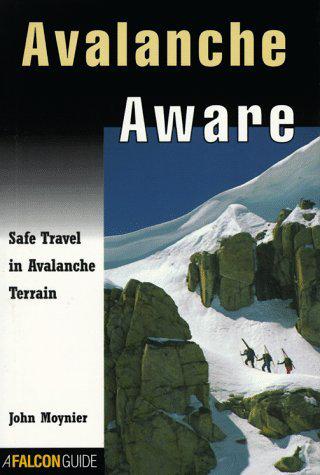A Narrow Escape
Surviving an avalanche in the northern Bridgers.
Super Bowl Sunday of 2011 was an unpredicted snow day, and I woke up to a ringing cell phone. It was a close friend looking for a ski partner. Before fully awakening, I’d left the house and was heading toward the northern Bridgers. Our destination was Frazier Basin; with 18 inches of light powder on a solid base, we were bound for a day of glory. After skiing into the basin, we followed an existing skin track up the face.
Atmospheric conditions remained stable, with cold and consistent mid-day temps. A thin layer of clouds hovered over the upper headwall as the last snowflakes drifted down. The targeted run was a 50-degree pitch on a southeast-facing aspect that was blanketed with a new layer of airy, unsettled, 2% snow-water-equivalent powder—premium Cold Smoke conditions. Growing up in Bozeman, I’d been skiing most of my life, and as I looked down at the steep and lengthy run, I knew we were going to push the limits of what was safely skiable. Yet my anxiety and misgivings gave way to anticipation, adrenaline, and the strong urge to ski.
On my first run, I descended carefully along the rib, making tight turns to avoid vision-hindering face shots. Although there was no sluffing from the new snow, avalanche danger seemed high. Coming to a stop far below the basin, a sense of liberation consumed me as I realized it was one of the best ski runs of my life. I watched my partner come down with a similar smile on his face, and I knew we had to go back up for another run.
We quickly navigated the ridgeline for a second summit and were back on top around 3pm. My partner went first this time, skiing directly down the fall line and then veering left, out of sight, to follow the main line. Moments later, he reappeared at the bottom of the basin, milking out the last of the turns. After seeing my partner out, I gradually moved along the ridgeline to a bigger and more exposed line. The entire slope was illuminated as the sun broke through. In my view, this was the ultimate ski terrain in the most ideal powder conditions. Unlike the previous run—when the visibility was poor and I was unsure about how the snow would react—I was now familiar with the snow, and welcomed the opportunity to redeem my original hesitancy. I dropped in directly on top of a small spine, and with all the speed I could build, hooked a right turn. With that soul-satisfying feeling of making the first fast cut, I initiated a strong left turn using my gaining momentum. As I entered the apex of the turn, I saw the entire snowpack directly in front of me collapse.
The slab broke exponentially faster than any of the previous avalanches I’d triggered. I watched the flanks crack downward like lightning 30 yards to either side of me. Instead of acting as one initially cohesive slab that subsequently fractures into multiple smaller pieces, this slab plunged like a waterfall. Although this wasn’t my first time below the crown of an avalanche, it was the first time I was too far from the sides to escape. I immediately accepted that there was no exit and that I’d likely be buried. I pointed my skis down the fall line and faced the runout of the slope 1,000 vertical feet below. I remember thinking, “This is not humanly survivable.” As I leaned back, enveloped in a cloud of snow, the world around me blurred and went black.
Although indisputably caught in an avalanche, I remained hopeful that the debris would run out ahead of me. I tried a last-ditch effort to exit the torrent of snow by cutting hard to the left, but was immediately dragged down into the rushing onslaught of debris. I was no longer a skier; I was a swimmer fighting a Class IV rapid. I gave it everything I had, as though each stroke was my last, and my head would eventually crack open from blunt-force trauma. Soon after swallowing me, the slide gained enormous speed and momentum. I felt my left leg snap. I’d been swallowed by an enormous white whale and was being crushed in its bowels.
I felt my body free-falling. The avalanche cascaded over the cliff band, and as I accelerated off the precipice, I wondered if the landing would be the end of the run or the end of my life. After what seemed like minutes, I realized I had landed on ground. Initially it was a struggle to reorient myself and begin swimming again, because I knew I was nearing the bottom of the run-out. Suddenly, everything came to a stop and told myself to take a deep breath, but I was unable to inhale. I had no air pocket and my mouth was packed with snow. Then I heard an eerie whumpf as the snowpack settled around me. I was buried alive.
I tried to move my body, but there was too much resistance and all I could manage was a slight movement of my right hand. As I lay in complete darkness, I wondered what would happen as my body passed from life into death. Nearing the end of consciousness, I reminded myself that I was still alive and to not give up now—not after fighting so hard. I thought about two factors: first, how deep I was, and second, what position was I in. Given that I wasn’t being crushed by the weight of the snowpack, I knew I wasn’t buried very deeply. When I tried adjusting my body, I realized I could partially move one of my legs. This sensation gave me encouragement and I started to push the snow with my right hand. At first I could barely manage the most marginal movement, and the feeling of helplessness was almost overwhelming. But with the last of my strength, my hand cleared a pathway to the surface and I was able to sense light above. I cleared my airway and drew a full breath. I was alive. Relief, gratitude, and humility washed over me.
With renewed strength, I freed my torso of debris. Although I tried pushing up on my legs, I quickly recalled my leg breaking during the initial descent. But the pain had yet to register, and by the time my partner reached me, I had my entire body out of the debris and was sitting downhill in a lounge-chair position. My partner called 911 and despite our remote location, he miraculously got through to dispatch. The intensity of surviving the avalanche gave me the ability to feel very little pain during the whole ordeal. At first, I was more surprised to be alive than concerned about my injury. Yet as time passed, I became worried about my broken femur—particularly since all we could do was wait for help. My condition was relatively stable, however, and it seemed likely I would be getting out of the basin before dark.
Eventually we heard the helicopter and saw a rescue team on the ridgeline. Once the team leader arrived at our location, he immediately expressed the urgency of the situation and our need to move rapidly and efficiently. If the helicopter was to land, I had to be relocated to the flat part of the basin. With no time to spare, the team picked me up and dragged me through the snow to the targeted pickup position. With only a few minutes of daylight remaining, the helicopter hovered on the snow at near full capacity. Getting dragged and loaded into the life-saving aircraft was the most relieving and exhausting experience of my life.
Within two hours of arriving at Bozeman Deaconess Hospital, I went into surgery to repair a clean mid-shaft transverse fracture of my left femur. Within a few days, I could get out of bed on crutches. During the first week of recovery, surreal moments of the avalanche would intensely come and go. Like many people who have suffered a near-death experience, I had an overwhelming sense of mortality and the fragility of life. At times it felt as if I were in some other reality: a dead man breathing air and hovering in some ephemeral existence. Everything seemed so bright and alive compared to the few seconds of all-consuming blackness I’d experienced on the mountain.
Falcon Guide’s 2006 edition of Avalanche Aware has a brief yet resonating excerpt entitled, “The Human Factor.” According to the authors, I fell into the classic “heuristic trap,” or rule-of-thumb shortcut in which the skier makes decisions based on “relying on what normally works to address complex situations. This often results in missing important clues and increasing our risk by assuming conditions are safer than they really are based on past experience.” My partner and I both recognized that we were taking a gamble with our lives, but I blatantly ignored the fact that the new snow was unstable due to an especially persistent sun crust on a heavily exposed southern aspect. I had gotten away with so many similarly adrenaline-driven gambles that I inherently assumed this time would be no exception. On the first run, I had fear and respect; on the second, I approached it with arrogance and pride and thus passed the threshold of rational thinking. Normally I would have skied next to my old tracks, but with the visibility and euphoric conditions of an epic power day, I felt like this was an opportunity every skier dreams of. I stopped thinking straight and I almost paid the price with my life.
Life is always an experiment. We don’t ever know for certain what the outcome is going to be—especially when we’re tempting Mother Nature. I know I’ll replay those terrifying moments many times over during the course of my skiing career, and I’ll surely be more wary for the rest of my remaining days. I will always yearn for the freedom of being on skis above an epic line—but I will forever remember the risks, and how lucky I was that fateful day in the Bridger Mountains.











